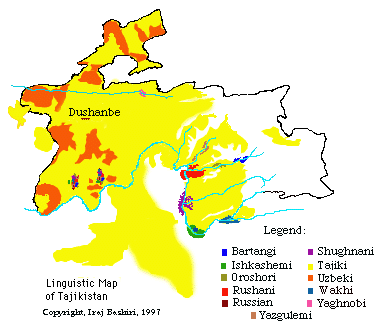Iraj Bashiri
copyright 1997


Direct descendants of the Sughdians, the Yaghnobis live in the upper
reaches of the Kuhistan region of Tajikistan (4,500 m. above sea level).
Sunni Muslims in religion, the Yaghnobis speak both Yaghnobi and Tajiki.
Their economy is based on agriculture and animal husbandry. According to
the Soviet Tajik Encyclopedia, their lifestyle is much the same as
that of their Tajik neighbors.
The population of Yaghnob proper is small in number for two reasons. First,
during the 16th and 17th centuries groups of Yaghnobis moved to the Varzab
region and settled in villages like Kupteppa, Zumand, Gharav, Ragh, and
Dara. Other group moved to the Hissar region in villages like Mavlanjara
Bala, Bishbulaq, and Kelitash. Those, however, were voluntary migrations.
During the stagnation years, but especially in the spring of 1970, the remainder
of the Yaghnobis were forced by the Soviet government to migrate to the
desolate Mirzachul region (Zafarabad) of northern Tajikistan (for Mirzachul,
see note below). Pleas and cries that they should be allowed to live in
their homeland did not move the officials who were determined to carry out
the decree of the leadership. At Mirzachul, as a result of extreme heat
to which the Yaghnobis' bodies could not adjust quickly enough, many died.
Out of a family of 18, for instance, only one returned to the Yaghnob valley.
Similarly, their language and culture became vulnerable to assaults by the
Tajiki and Uzbeki languages of northern Tajikistan.
The reasons given for the migration of the Yaghnobis are varied. They range
from forced resettlement to voluntary migration. What is certain is that
Soviet authorities placed the Yaghnobis and their belongings into trucks
and moved them. It is also certain that at the time there was a need for
cotton workers in Mirzachul, especially when the number of sovkhozes grew
(5 for cotton and one for forestry). But why would the upper echelon of
the Soviet government want the elimination of the remnants of the Sughdian
language and culture, especially if the 16,000 hectares of cultivation under
Yaghnobis' jurisdiction provided potatoes, vegetables, meat, milk, and wool
for not only Leninabad (now Khujand) but for the republic of Tajikistan
as a whope? The Yaghnobis, it was argued, were uneducated. They did not
enjoy many of the amenities that were readily available to the other Soviets.
These amenities included roads, electricity, communication lines, schools,
medical facilities, stores, post office, library, and the like. Moving into
more developed regions, it was decided, would improve their education and,
thereby, their liability to meaningful labor. This would also free their
rich grasslands, natural growths that grew on the slopes, for the use by
the cattle herders.
The future of the 300 Yaghnobis who have lost their families in Mirzachul
and who have returned to Yaghnob to begin a new life is in doubt. If their
other neighbors, the Orjanikizada Kolkhoz, for instance, and the Tajik government
cooperate and build a road to bring commerce to Yaghnob and if the other
amenities enjoyed by neighboring regions are provided, the Yaghnobis will
survive. Hopefully, the rest of their people would return and they would
resume their old ways. If not, the language and culture of the ancient Sughdians
will be met with yet another set back. This one, delivered by their kin,
the Tajiks, could be fatal. Their Aini neighbors ("Tajikistan"
rayon) who, in the absence of the Yaghnobis, have constructed a make-shift
road through Yaghnobi territory are very much interested in the future of
the Yaghnobis. They wonder if they may have to surrender the slopes they
use as pasture land for their cattle back to the Yaghnobis.
Sources
Saidmurad Khalzada, Sada-i Sharq, II, 1989, pp. 140-41.
"Yaghnobiha," Soviet Tajik Encyclopedia, vol. 8, 1988.
Note on Mirzachul
Divided between Kazakhstan (Chimkent), Uzbekistan (Syr Darya) and Tajikistan
(Leninabad), Mirzachul is the lowest geographical point (250-300 m.) of
the republic and a most windy place. The Zafarabad region of Mirzachul was
given to Tajikistan in 1958 by Uzbekistan for the cultivation of cotton.
It is irrigated by two major canals--Tajikistan I and Tajikistan II. The
climate of Mirzachul is hot and dry (27.9° c.) during the summer and
cold (-2.1° c) with little rain during winter.